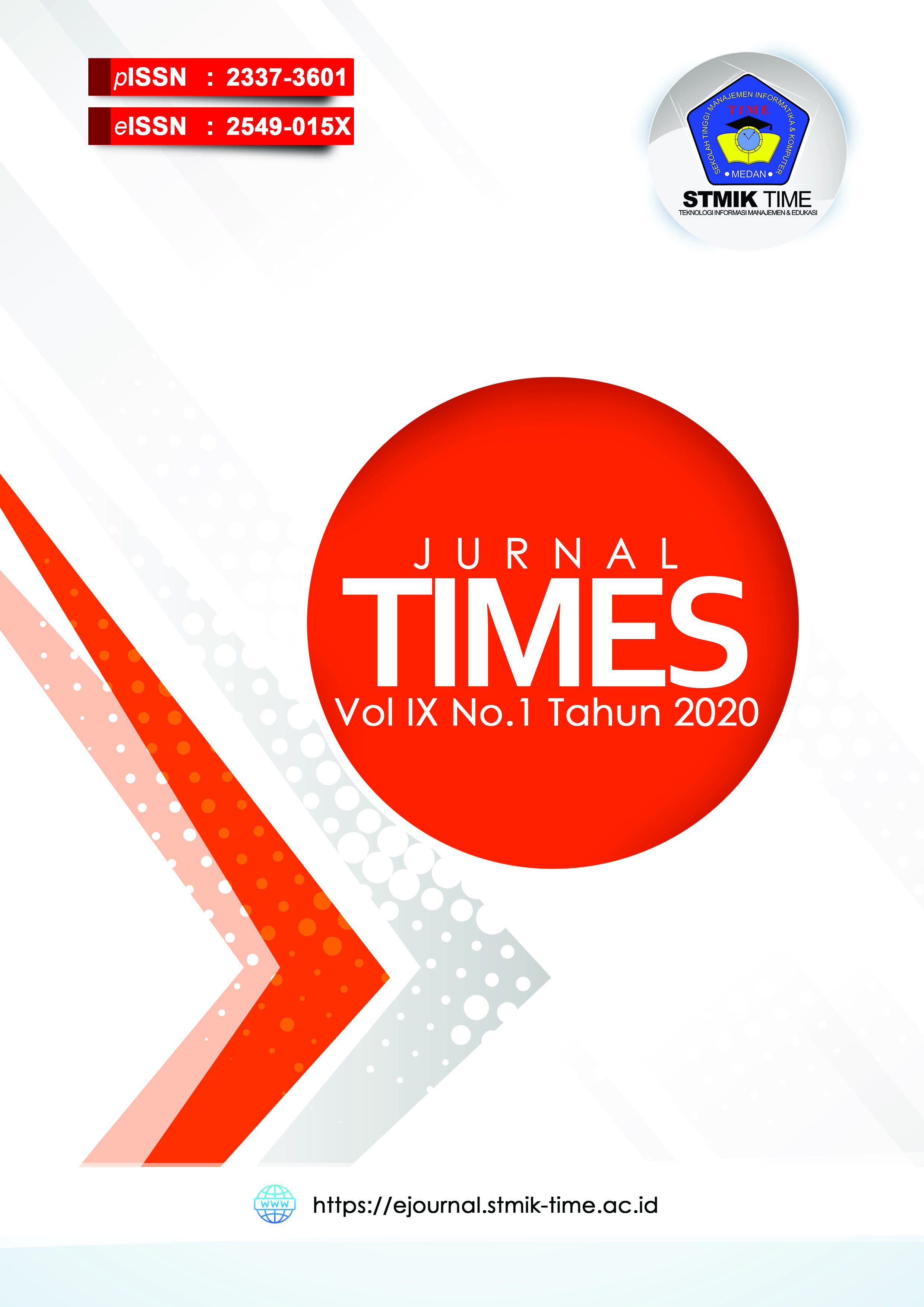Pendekatan Level Data untuk Menangani Ketidakseimbangan Data Menggunakan Algoritma K-Nearest Neighbor
Isi Artikel Utama
Abstrak
Rincian Artikel
Referensi
A Hybrid Approach from Ant Colony Optimization ... (n.d.). 13.
Ali, A., Shamsuddin, S. M., & Ralescu, A. L. (n.d.). Classification with class imbalance problem: A review. 31.
Bolón-Canedo, V., Sánchez-Maroño, N., & Alonso-Betanzos, A. (2014). Data classification using an ensemble of filters. Neurocomputing, 135, 13–20. https://doi.org/10.1016/j.neucom.2013.03.067
Chawla, N. V., Bowyer, K. W., Hall, L. O., & Kegelmeyer, W. P. (2002). SMOTE: Synthetic Minority Over-sampling Technique. Journal of Artificial Intelligence Research, 16, 321–357. https://doi.org/10.1613/jair.953
Chung, H.-Y., Ho, C.-H., & Hsu, C.-C. (2011). Support vector machines using Bayesian-based approach in the issue of unbalanced classifications. Expert Systems with Applications, 38(9), 11447–11452. https://doi.org/10.1016/j.eswa.2011.03.018
Cordón, I., GarcÃa, S., Fernández, A., & Herrera, F. (2018). Imbalance: Oversampling algorithms for imbalanced classification in R. Knowledge-Based Systems, 161, 329–341. https://doi.org/10.1016/j.knosys.2018.07.035
Department of Biological Sciences, BITS PILANI K K Birla Goa Campus, Zuarinagar, Vasco Da Gama, India, & Kothandan, R. (2015). Handling class imbalance problem in miRNA dataset associated with cancer. Bioinformation, 11(1), 6–10. https://doi.org/10.6026/97320630011006
Douzas, G., & Bacao, F. (2019). Geometric SMOTE a geometrically enhanced drop-in replacement for SMOTE. Information Sciences, 501, 118–135. https://doi.org/10.1016/j.ins.2019.06.007
Douzas, G., Bacao, F., & Last, F. (2018). Improving imbalanced learning through a heuristic oversampling method based on k-means and SMOTE. Information Sciences, 465, 1–20. https://doi.org/10.1016/j.ins.2018.06.056
Duan, L., Xie, M., Bai, T., & Wang, J. (2016). A new support vector data description method for machinery fault diagnosis with unbalanced datasets. Expert Systems with Applications, 64, 239–246. https://doi.org/10.1016/j.eswa.2016.07.039
Farquad, M. A. H., & Bose, I. (2012). Preprocessing unbalanced data using support vector machine. Decision Support Systems, 53(1), 226–233. https://doi.org/10.1016/j.dss.2012.01.016
Han, W., Huang, Z., Li, S., & Jia, Y. (2019). Distribution-Sensitive Unbalanced Data Oversampling Method for Medical Diagnosis. Journal of Medical Systems, 43(2). https://doi.org/10.1007/s10916-018-1154-8
Huang, W., & Fitzmaurice, G. M. (2005). Analysis of longitudinal data unbalanced over time. Journal of the Royal Statistical Society: Series B (Statistical Methodology), 67(1), 135–155. https://doi.org/10.1111/j.1467-9868.2005.00492.x
Juan Carbajal-Hernández et al. - 2016—Classification of unbalance and misalignment in in.pdf. (n.d.).
Juan Carbajal-Hernández, J., Sánchez-Fernández, L. P., Hernández-Bautista, I., Medel-Juárez, J. de J., & Sánchez-Pérez, L. A. (2016). Classification of unbalance and misalignment in induction motors using orbital analysis and associative memories. Neurocomputing, 175, 838–850. https://doi.org/10.1016/j.neucom.2015.06.094
Khalilpour Darzi, M. R., Niaki, S. T. A., & Khedmati, M. (2019). Binary classification of imbalanced datasets: The case of CoIL challenge 2000. Expert Systems with Applications, 128, 169–186. https://doi.org/10.1016/j.eswa.2019.03.024
Lee, C.-Y., & Lee, Z.-J. (2012). A novel algorithm applied to classify unbalanced data. Applied Soft Computing, 12(8), 2481–2485. https://doi.org/10.1016/j.asoc.2012.03.051
Lee, J., Wu, Y., & Kim, H. (2015). Unbalanced data classification using support vector machines with active learning on scleroderma lung disease patterns. Journal of Applied Statistics, 42(3), 676–689. https://doi.org/10.1080/02664763.2014.978270
Maldonado, S., López, J., & Vairetti, C. (2019). An alternative SMOTE oversampling strategy for high-dimensional datasets. Applied Soft Computing, 76, 380–389. https://doi.org/10.1016/j.asoc.2018.12.024
Prusty, M. R., Jayanthi, T., & Velusamy, K. (2017). Weighted-SMOTE: A modification to SMOTE for event classification in sodium cooled fast reactors. Progress in Nuclear Energy, 100, 355–364. https://doi.org/10.1016/j.pnucene.2017.07.015
Qiong, G. (2016). An Improved SMOTE Algorithm Based on Genetic Algorithm for Imbalanced. 14(2), 12.
Raghuwanshi, B. S., & Shukla, S. (2019). SMOTE based class-specific extreme learning machine for imbalanced learning. Knowledge-Based Systems. https://doi.org/10.1016/j.knosys.2019.06.022
Rout, N., Mishra, D., & Mallick, M. K. (2018). Handling Imbalanced Data: A Survey. In M. S. Reddy, K. Viswanath, & S. P. K.M. (Eds.), International Proceedings on Advances in Soft Computing, Intelligent Systems and Applications (Vol. 628, pp. 431–443). Springer Singapore. https://doi.org/10.1007/978-981-10-5272-9_39
Searle, S. R. (1994). Analysis of Variance Computing Package Output for Unbalanced Data from Fixed-Effects Models with Nested Factors. The American Statistician, 48(2), 148. https://doi.org/10.2307/2684275
Sun, J., Lang, J., Fujita, H., & Li, H. (2018). Imbalanced enterprise credit evaluation with DTE-SBD: Decision tree ensemble based on SMOTE and bagging with differentiated sampling rates. Information Sciences, 425, 76–91. https://doi.org/10.1016/j.ins.2017.10.017
Sun, J., Li, H., Fujita, H., Fu, B., & Ai, W. (2020). Class-imbalanced dynamic financial distress prediction based on Adaboost-SVM ensemble combined with SMOTE and time weighting. Information Fusion, 54, 128–144. https://doi.org/10.1016/j.inffus.2019.07.006
Sun, Y., Wong, A. K. C., & Kamel, M. S. (2009). CLASSIFICATION OF IMBALANCED DATA: A REVIEW. International Journal of Pattern Recognition and Artificial Intelligence, 23(04), 687–719. https://doi.org/10.1142/S0218001409007326
Sundarkumar, G. G., & Ravi, V. (2015). A novel hybrid undersampling method for mining unbalanced datasets in banking and insurance. Engineering Applications of Artificial Intelligence, 37, 368–377. https://doi.org/10.1016/j.engappai.2014.09.019
Verbiest, N., Ramentol, E., Cornelis, C., & Herrera, F. (2014). Preprocessing noisy imbalanced datasets using SMOTE enhanced with fuzzy rough prototype selection. Applied Soft Computing, 22, 511–517. https://doi.org/10.1016/j.asoc.2014.05.023
Wang, K.-J., Makond, B., Chen, K.-H., & Wang, K.-M. (2014). A hybrid classifier combining SMOTE with PSO to estimate 5-year survivability of breast cancer patients. Applied Soft Computing, 20, 15–24. https://doi.org/10.1016/j.asoc.2013.09.014
Wu, Q., Ye, Y., Zhang, H., Ng, M. K., & Ho, S.-S. (2014). ForesTexter: An efficient random forest algorithm for imbalanced text categorization. Knowledge-Based Systems, 67, 105–116. https://doi.org/10.1016/j.knosys.2014.06.004
Zhang, L., Zhang, C., Gao, R., Yang, R., & Song, Q. (2016). Using the SMOTE technique and hybrid features to predict the types of ion channel-targeted conotoxins. Journal of Theoretical Biology, 403, 75–84. https://doi.org/10.1016/j.jtbi.2016.04.034
